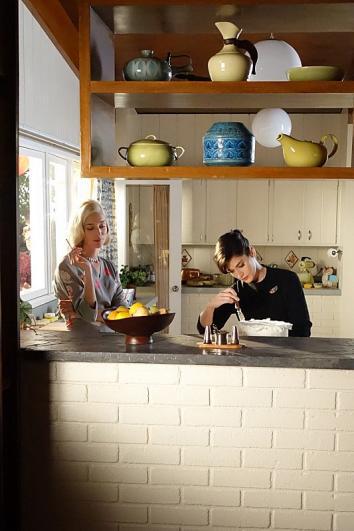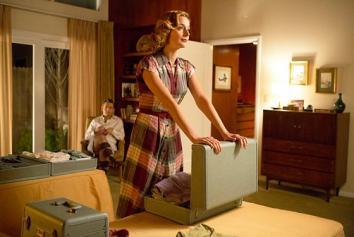Mad Men has trained a generation of TV watchers to become eagle-eyed connoisseurs of Saarinen furniture, IBM Selectric Typewriters, and Western Electric Model 500 telephones, raising the bar for set designers who are acutely aware that accuracy counts. But designers also know that television sets are not museum installations: The verisimilitude of physical details must work in tandem with aesthetic choices that help us understand who characters are.
Showtime’s Masters of Sex, which centers on real-life sex researchers William Masters and Virginia Johnson, grapples with this new TV reality as much or more than any other series currently on the air. The series takes place in St. Louis in the 1950s, and its set design is a skillful blend of historical accuracy and poetic liberty. The Eisenhower-era milieu is carefully recreated in every detail, from the glass bottles and syringes used in medical scenes to the nipped-in silhouettes of the female characters’ wardrobes. The design of “Ulysses,” the evocatively named device that Masters and Johnson use to record sexual responses in their female subjects, was inspired by actual descriptions of the dildo-plus-camera. The result looks like something Norman Bel Geddes might have created if the “World of Tomorrow” exhibition at the 1939 World’s Fair had had an adults-only section.

Still from Masters of Sex courtesy of Showtime
The main sites of dramatic activity on the show are the Masters’ home and the various St. Louis hospitals where Dr. Masters sets up his professional headquarters. The hospital settings are largely traditional and even quaint, but the Masters’ home is a Dwell magazine-worthy ranch house decorated in a bright, modern color palette and chic George Nelson hanging lamps. If it seems to suit them perfectly, well, that’s a bit of artistic sleight-of-hand: Libby and Bill Masters’ real life house didn’t look anything like this. According to Thomas Maier’s biography of Dr. Masters and Virginia Johnson, an inspiration for the Showtime series, the real Masters lived in a “brick, two-story Dutch Colonial” in the town of Ladue, an affluent suburb of St. Louis, where Libby Masters entertained well-heeled friends from St. Peter’s Episcopal Church, and gave parties that were “stylish and cheery,” if not ultra-modern.

Still from Masters of Sex courtesy of Showtime
But Andrew Jackness, production designer for the show’s pilot, told me that he made the Masters’ home fresh and contemporary, on the cutting edge of domestic interior design for that era, so that audiences would understand Bill Masters as a modern forward-thinking, path-breaking man of science.* In an effort to conjure the image of a visionary—the Charles Eames of sex research, perhaps—series creator Michelle Ashford described the Masters’ home in her original script as “Eichler-style,” a reference to the California real estate developer whose sophisticated tract houses made him a kind of William Levitt for middle class modernists. Eichler’s tract houses number in the thousands, and usually feature open floor plans and large transom windows to minimize the visual barrier between interior and exterior. Quite the opposite of the traditional manse that the real Masters occupied, in other words, which probably looked more like Don and Betty Draper’s colonial revival Ossining abode prior to their divorce.
Fictional though this home is, Jackness did his research on the Masters’ imaginary domestic modernism, poring over magazines and books, particularly the Italian design magazine Domus, and settling on a period-appropriate color palette of soft blue and mustard yellow with bold red and orange accents. The 1957 house his team found to serve as the Masters’ home bore an “uncanny” similarity to the looks he saw in his research, and even had its original blue kitchen and built-in appliances intact. Jackness added some red and white shelving to give it an additional burst of color. The look of the home is picture-perfect Atomic age design, down to the exposed beams, Masonite paneling painted matte white, clusters of post-war studio pottery, biomorphic blown-glass lighting fixtures, and monochromatic upholstered furniture and drapes.

Still from Masters of Sex courtesy of Showtime
According to Richard Wright, an expert on post-war and contemporary design, the look and feel of Masters of Sex is quite accurate to the period—although, he notes, true modernist domestic interiors were not all that common. “A far greater percentage of people today are interested in modern and contemporary design than back then,” he says. With our eyes trained on the vintage gems of that period’s avant garde, we may expect an authority-defying scientist whose research helped usher in the sexual revolution to have the latest designs in his own home. Nostalgia is a factor as well. “Postwar America was a time that brimmed with optimism,” notes Wright. And we have come to associate 1950s design with that forward-looking hopefulness.
And so, on the series, Chez Masters is a bright, stylish oasis amid the stiflingly traditional interiors full of brass chandeliers and overstuffed wing chairs. It may be a fictional flourish, but it tells a visual story that matches the themes of the show. Dr. Masters looks the part of a buttoned-up Midwestern doctor, but his home is a clear metaphor for an entirely new way of living.

Still from Masters of Sex courtesy of Showtime
Correction, Sept. 10, 2014: This post originally misidentified Andrew Jackness as the series production designer. He was the production designer on the pilot.
